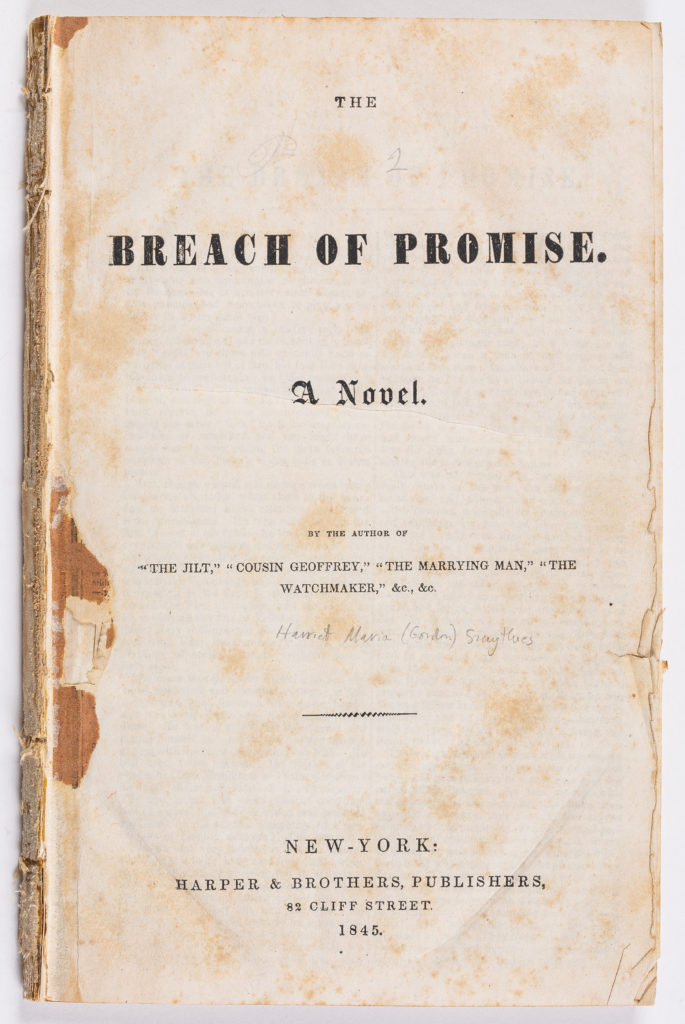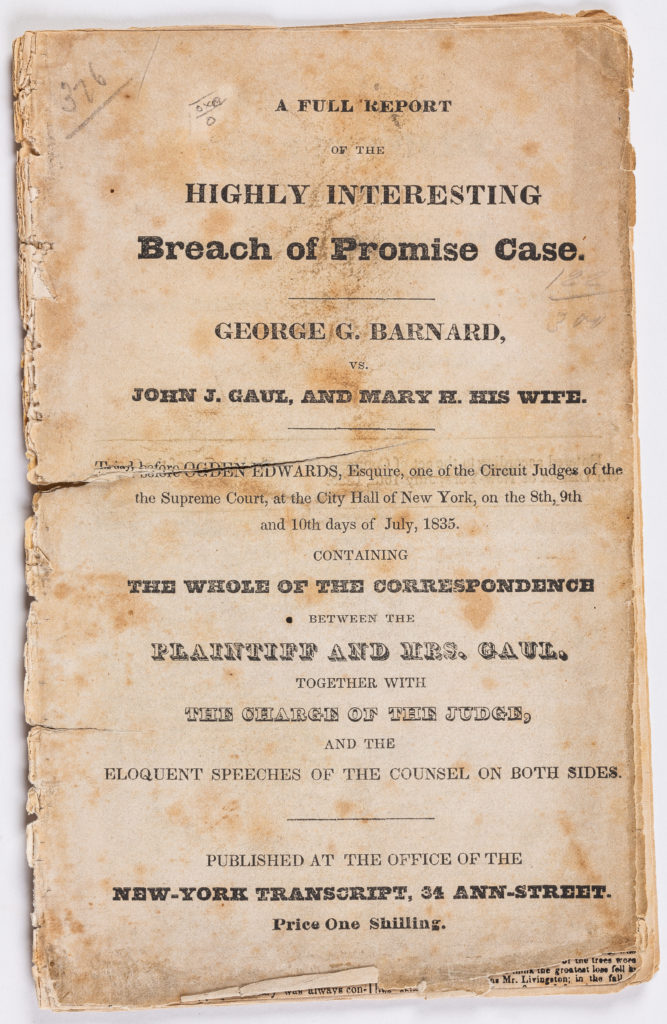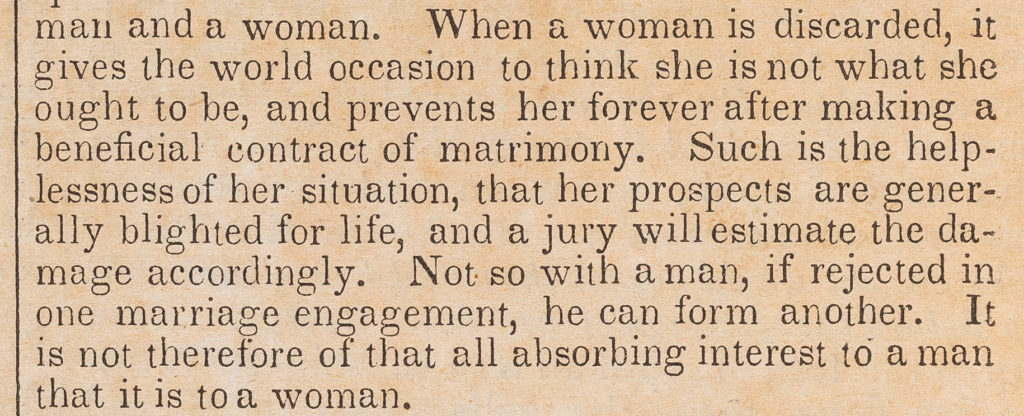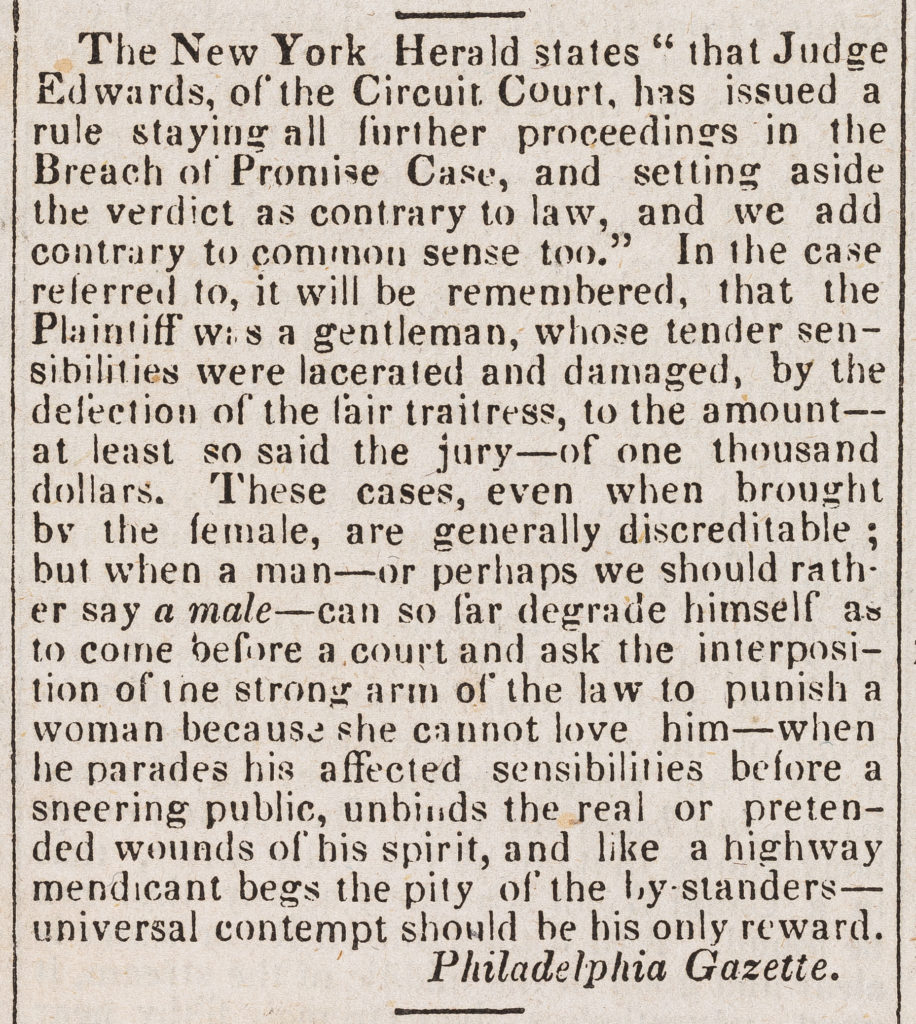Here at AAS, we’ve always enjoyed Valentine’s Day. From various blog posts to our online exhibit on Victorian Valentines, we have fun promoting the holiday. This year, we thought we’d go in a different direction and look at what could happen when love doesn’t go as planned.
 Breach of promise lawsuits occurred when a person, usually a woman, sued their ex-fiancé for ending their engagement. They argued that an engagement constituted a legal contract and that breaking it deserved monetary compensation. Now virtually unheard of – and illegal in many states – breach of promise lawsuits were common in the 19th century. They appear in our collection in the form of newspaper articles, personal accounts, reports of court cases, and novels.
Breach of promise lawsuits occurred when a person, usually a woman, sued their ex-fiancé for ending their engagement. They argued that an engagement constituted a legal contract and that breaking it deserved monetary compensation. Now virtually unheard of – and illegal in many states – breach of promise lawsuits were common in the 19th century. They appear in our collection in the form of newspaper articles, personal accounts, reports of court cases, and novels.
One example is the eight-page pamphlet entitled Report of the case of Mary Conrad versus Josiah B. Williams. This breach of promise is particularly compelling because Mary Conrad and Josiah Williams were never actually engaged. Nevertheless, Mary was awarded $8,000 from a New York circuit court judge in 1843. Josiah appealed to the New York Supreme Court for a retrial in the following year, occasioning the publication of this pamphlet.
Mary’s lawyer argued that, while the two were never officially engaged, Josiah had promised to “marry the plaintiff, if he ever married any one.” When Josiah married another woman in 1842, this promise was broken. The defense argued that no commitment had been made and that, if it had, it was not unconditional.
To my twenty-first century ears, the story of their courtship reads like teenage drama: Josiah called upon Mary “more than a dozen times,” asked her to join him on a sleigh ride and even walked with her several times! One witness for the defense told the jury that while Josiah did walk with Mary at a party for a time, “he walked a part of the evening with another lady.” As for the sleigh ride, Josiah was “riding with several ladies.” There was only one witness who could attest to the promise of future engagement, Mary’s sister Frances, who only heard because she was eavesdropping from the next room.
Whatever their relationship had been, it dwindled to nothing, and, after 8 months with no contact, Mary became aware that Josiah was engaged to another woman. She was so distraught that she “was immediately taken with spasms, such as the attending physicians had never before seen or heard of.” According to Frances, the following cringe-worthy exchange occurred when Josiah visited Mary at her sick bed. “The plaintiff said, ‘Mr. Williams, didn’t you tell me you would marry me when you married anyone?’ He said he did; but it was only to calm her feelings.”
In the end, the New York Supreme Court agreed with Josiah that “an absolute promise of marriage had not been made,” and Josiah was awarded a retrial. Contemporary newspaper articles confirm that the case was retried in 1846, and this time the jury ruled in Josiah’s favor.
 Another example is the 1835 pamphlet, A full report of the highly interesting breach of promise case. George G. Barnard, vs. John J. Gaul, and Mary H. his wife. This document gives a detailed account of a case brought to the New York Supreme Court, in which George Barnard sues both his ex-fiancée and her new husband for $10,000. It describes the former couple’s courtship and includes dozens of letters between Mary and George from 1827 to 1833, when Mary ends their engagement and marries John.
Another example is the 1835 pamphlet, A full report of the highly interesting breach of promise case. George G. Barnard, vs. John J. Gaul, and Mary H. his wife. This document gives a detailed account of a case brought to the New York Supreme Court, in which George Barnard sues both his ex-fiancée and her new husband for $10,000. It describes the former couple’s courtship and includes dozens of letters between Mary and George from 1827 to 1833, when Mary ends their engagement and marries John.
The defense portrays Mary as a sweet, guileless woman, manipulated into entering an engagement with George and who narrowly escapes marriage to a man who treated her with “cold brutality.” The council for the plaintiff paints a different picture all together. He characterizes George as an innocent, heartbroken victim who has been coldly treated by Mary, an unreliable, senseless hypocrite who had “prostituted her moral sentiments.”
After closing arguments, the judge entreats the jury to remember “when a woman is discarded, it gives the world occasion to think she is not what she ought to be, and prevents her forever after making beneficial contract of matrimony . . . not so with a man, if rejected in one marriage engagement, he can form another.” Despite the judge’s words, the jury found “in favor of the plaintiff for one thousand dollars, and costs of trial.” Apparently, this was not a popular decision.
The New York Herald reported that “Judge Edwards of the Circuit Court has issued a rule staying all further proceedings in the Breach of Promise Case and setting aside the verdict as contrary to law, and we add contrary to common sense too.” News of the case was reprinted throughout the region, including the July 28, 1835 issue of the Connecticut Herald, seen below.

We can only speculate as to what the outcome of these cases would have been had women been included on the jury. Regardless of sex, public sentiment seemed to lie primarily with the defendants, “These cases…even when brought by the female, are generally discreditable; but when a man; or perhaps we should rather say a male–can so far degrade himself as to…punish a woman because she cannot love him…universal contempt should be his only reward.”

We wish you a happy, lawsuit-free Valentine’s Day!

